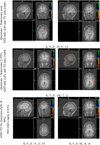The neural underpinnings of prosody in autism
- PMID: 22176162
- PMCID: PMC3461129
- DOI: 10.1080/09297049.2011.639757
The neural underpinnings of prosody in autism
Abstract
This study examines the processing of prosodic cues to linguistic structure and to affect, drawing on fMRI and behavioral data from 16 high-functioning adolescents with autism spectrum disorders (ASD) and 11 typically developing controls. Stimuli were carefully matched on pitch, intensity, and duration, while varying systematically in conditions of affective prosody (angry versus neutral speech) and grammatical prosody (questions versus statement). To avoid conscious attention to prosody, which normalizes responses in young people with ASD, the implicit comprehension task directed attention to semantic aspects of the stimuli. Results showed that when perceiving prosodic cues, both affective and grammatical, activation of neural regions was more generalized in ASD than in typical development, and areas recruited reflect heightened reliance on cognitive control, reading of intentions, attentional management, and visualization. This broader recruitment of executive and "mind-reading" brain areas for a relative simple language-processing task may be interpreted to suggest that speakers with high-functioning autism (HFA) have developed less automaticity in language processing and may also suggest that "mind-reading" or theory of mind deficits are intricately bound up in language processing. Data provide support for both a right-lateralized as well as a bilateral model of prosodic processing in typical individuals, depending upon the function of the prosodic information.
Figures


Similar articles
-
Influences of semantic and prosodic cues on word repetition and categorization in autism.J Speech Lang Hear Res. 2014 Oct;57(5):1764-78. doi: 10.1044/2014_JSLHR-L-13-0123. J Speech Lang Hear Res. 2014. PMID: 24801807
-
Hemispheric differences in language processing in autism spectrum disorders: A meta-analysis of neuroimaging studies.Autism Res. 2016 Oct;9(10):1046-1057. doi: 10.1002/aur.1599. Epub 2016 Jan 11. Autism Res. 2016. PMID: 26751141
-
Neural basis of irony comprehension in children with autism: the role of prosody and context.Brain. 2006 Apr;129(Pt 4):932-43. doi: 10.1093/brain/awl032. Epub 2006 Feb 15. Brain. 2006. PMID: 16481375 Free PMC article.
-
Affective prosody disorders in adults with neurological conditions: A scoping review.Int J Lang Commun Disord. 2023 Nov-Dec;58(6):1939-1954. doi: 10.1111/1460-6984.12909. Epub 2023 May 22. Int J Lang Commun Disord. 2023. PMID: 37212522
-
Prosody in autism spectrum disorders: a critical review.Int J Lang Commun Disord. 2003 Oct-Dec;38(4):325-50. doi: 10.1080/1368282031000154204. Int J Lang Commun Disord. 2003. PMID: 14578051 Review.
Cited by
-
Emotional prosody processing in autism spectrum disorder.Soc Cogn Affect Neurosci. 2017 Feb 1;12(2):224-239. doi: 10.1093/scan/nsw118. Soc Cogn Affect Neurosci. 2017. PMID: 27531389 Free PMC article.
-
Atypical brain lateralization for speech processing at the sublexical level in autistic children revealed by fNIRS.Sci Rep. 2024 Feb 2;14(1):2776. doi: 10.1038/s41598-024-53128-7. Sci Rep. 2024. PMID: 38307983 Free PMC article.
-
Music-Enhanced Emotion Identification of Facial Emotions in Autistic Spectrum Disorder Children: A Pilot EEG Study.Brain Sci. 2022 May 30;12(6):704. doi: 10.3390/brainsci12060704. Brain Sci. 2022. PMID: 35741590 Free PMC article.
-
Developmental language disorders: challenges and implications of cross-group comparisons.Folia Phoniatr Logop. 2013;65(2):68-77. doi: 10.1159/000353896. Epub 2013 Aug 12. Folia Phoniatr Logop. 2013. PMID: 23942044 Free PMC article. Review.
-
Evaluating the importance of social motor synchronization and motor skill for understanding autism.Autism Res. 2017 Oct;10(10):1687-1699. doi: 10.1002/aur.1808. Epub 2017 Jun 7. Autism Res. 2017. PMID: 28590041 Free PMC article.
References
-
- Aizenstein H, Stenger V, Cochran J, Clark K, Johnson M, Nebes R, et al. Regional brain activation during concurrent implicit and explicit sequence learning. Cerebral Cortex. 2004;14(2):199–208. - PubMed
-
- American Psychiatric Association. DSM-5 Development, A 09 Autism Spectrum Disorder Proposed Revision. 2011 Jan; Retrieved from http://www.dsm5.org/ProposedRevisions/Pages/proposedrevision.aspx?rid=94.
-
- Baltaxe CA. Use of contrastive stress in normal, aphasic, and autistic children. Journal of Speech and Hearing Research. 1984;24:97–105. - PubMed
-
- Baltaxe CA, D'Angiola N. Cohesion in the discourse interaction of autistic, specifically language-impaired, and normal children. Journal of Autism and Developmental Disorders. 1992;22(1):1–21. - PubMed
Publication types
MeSH terms
Grants and funding
LinkOut - more resources
Full Text Sources
